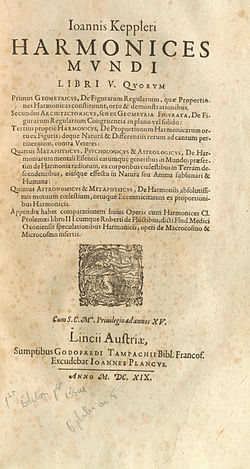
Back হারমোনিকেস মুন্দি Bengali/Bangla Harmonices Mundi Catalan Harmonices mundi Czech Harmonices Mundi Welsh Harmonices Mundi Danish Harmonice mundi German Harmonices Mundi Esperanto Harmonices mundi Spanish Harmonices mundi Estonian هارمونی جهان Persian
 1619 first edition | |
| Author | Johannes Kepler |
|---|---|
| Language | Latin |
| Subject | Astronomy, Music |
| Publisher | Linz |
Publication date | 1619 |
Harmonice Mundi (Latin: The Harmony of the World, 1619) is a book by Johannes Kepler. In the work, written entirely in Latin, Kepler discusses harmony and congruence in geometrical forms and physical phenomena. The final section of the work relates his discovery of the so-called third law of planetary motion.[1]
The full title is Harmonices mundi libri V (The Five Books of The Harmony of the World), which is commonly but ungrammatically shortened to Harmonices mundi.[2][3]
- ^ Johannes Kepler, Harmonice Mundi [The Harmony of the World] (Linz, (Austria): Johann Planck, 1619), p. 189. From the bottom of p. 189: "Sed res est certissima extactissimaque quod proportio qua est inter binorum quorumcunque Planetarum tempora periodica, sit præcise sesquialtera proportionis mediarum distantiarum, id est Orbium ipsorum; ..." (But it is absolutely certain and exact that the proportion between the periodic times of any two planets is precisely the sesquialternate proportion [i.e., the ratio of 3:2] of their mean distances, that is, of the actual spheres, ..."
An English translation of Kepler's Harmonice Mundi is available as: Johannes Kepler with E. J. Aiton, A. M. Duncan, and J. V. Field, trans., The Harmony of the World (Philadelphia, Pennsylvania: American Philosophical Society, 1997); see especially p. 411. - ^ Caspar, Max (1993) [1959]. Kepler. Translated by Hellman, C. Doris (reprint ed.). Dover. p. 288. ISBN 0-486-67605-6.
- ^ Gabor, Paul; Petrovićová, Katarina (2021). "It's All Greek: Three of Kepler's Book Titles" (PDF). Journal of Astronomical History and Heritage. 24 (3): 652–664. Bibcode:2021JAHH...24..652G.
© MMXXIII Rich X Search. We shall prevail. All rights reserved. Rich X Search